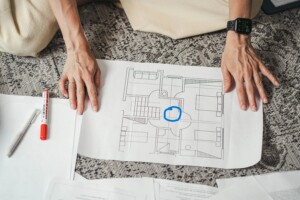
In feng shui theory, each part of the house can be ranked in order of its importance or affect on the occupants. The very center of the house can be seen as the “guts” or navel point. Often it includes a hallway or pass through area. The center point may also land in an actual room.
The energy which resides at the center of a house actually radiates throughout the entire house and can dictate the basic personality of the home. The center represents the hidden potential of what the occupants may experience. What triggers this energy into being active can be a combination of yearly influences, design and décor features to the floor plan, even the occupant’s personal compatibility or incompatibility with their space.
What surprises many is how specific feng shui can get. Much of the information is derived from time/space calculation, like astrology for architecture. Most Westerners do not yet practice feng shui on this high level. There are hundreds of houses types, but I will highlight the potential for a short list of very common house types to give you an idea of how personal the information can be.
1930’s house facing West: the occupants can be powerful but lonely.
1950’s house facing South: the occupants can have heart of eye problems.
1970’s house facing North: the woman dominates the man, easy to get divorced.
1990’s house facing East: not good for high risk stocks and investments.
A late 1920’s house facing Southwest: the woman in the house looks younger than she is.
A late 1940’s house facing Northeast: the occupants can be rich but not healthy.
A late 1960’s house facing Northwest: occupants had more money struggles 1984-2004.
A late 1980’s house facing Southeast: more difficult to have children 2004-2024.
The energy associated with the center of the house can affect a person’s health, relationships, and financial status. And there can be other influences which make its potential better or worse. This is discussed at length in the chapter, “Hidden Agenda of your House” in my second book, The Feng Shui Matrix.
As an example, many houses have basically a square or rectangular shape, but sometimes the floor plan has an extended area. This is almost like a person stretching their arms out away from their body. That pulling or tugging of the center point of the house is one way that the center energy can become more active or influential.
If a house is missing the center (like an open central patio or courtyard), then it generally weakens the nature of the house. This is not so true for commercial buildings, which often have atriums.
It is also considered a poor feng shui design to have a kitchen in the center of the house. The actual fire and heat from the kitchen could easily irritate the central energy of the house. The center of a house can be defined as real space, as much as any other part of the house. But the information we get from Feng Shui calculations is only metaphorically referring to the central “palace” of a house. As mentioned, the personality of the house or the center palace flying stars will permeate the whole house. The center stars are not confined to the center, to remedy with elements like the more literal eight basic directions.
Author: Kartar Diamond
Company: Feng Shui Solutions ®
From the Feng Shui Theory Blog Series

